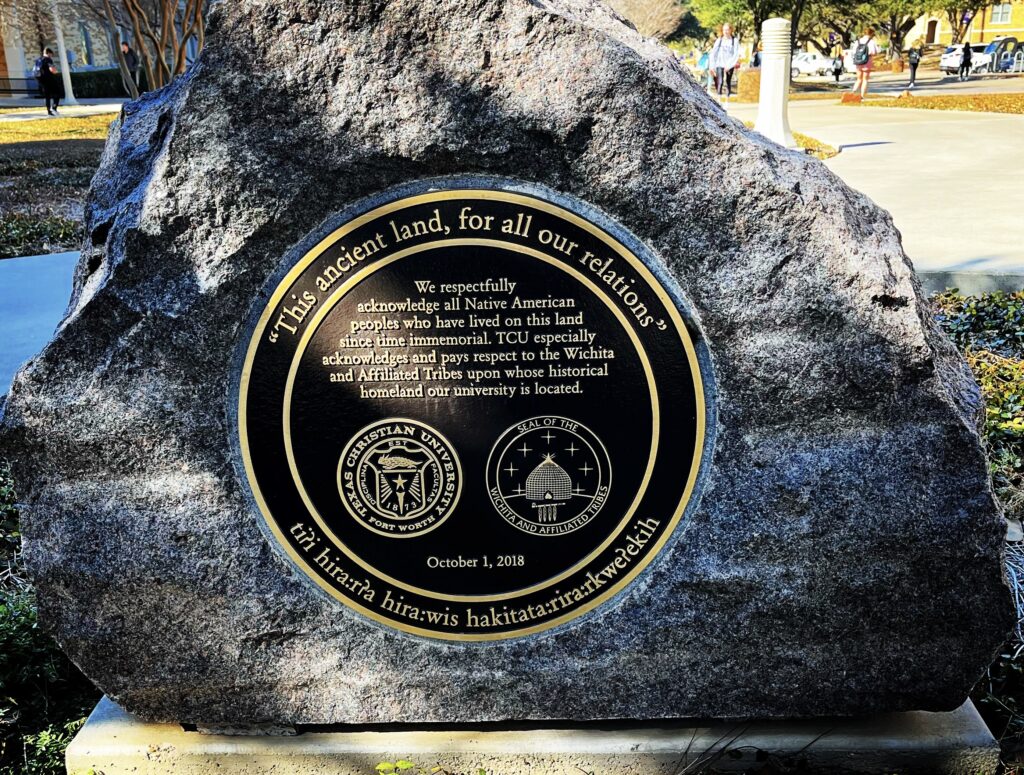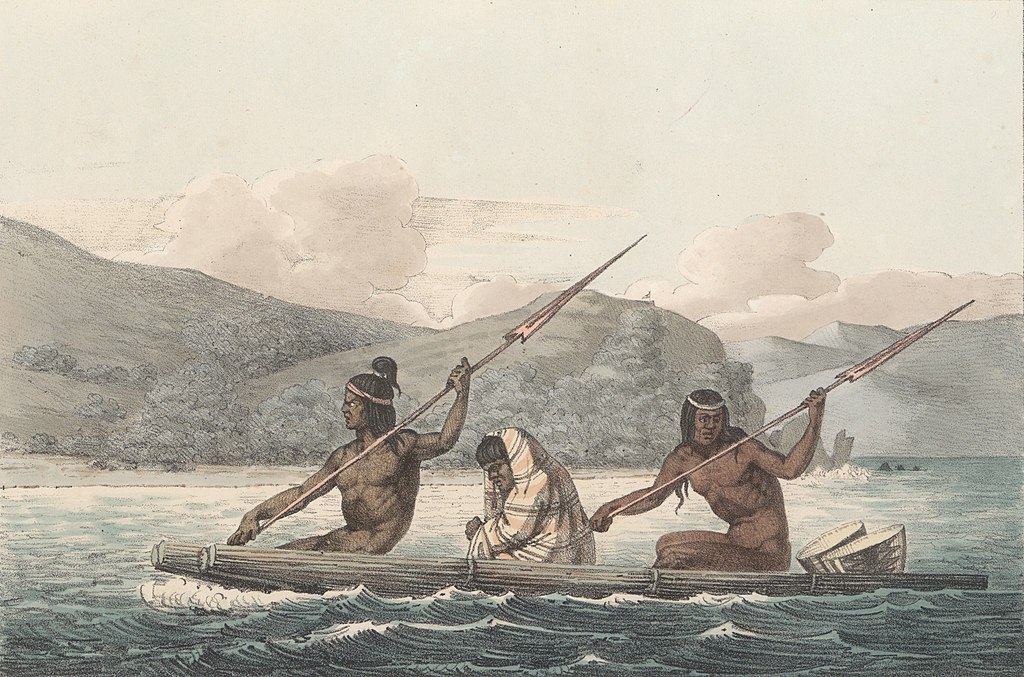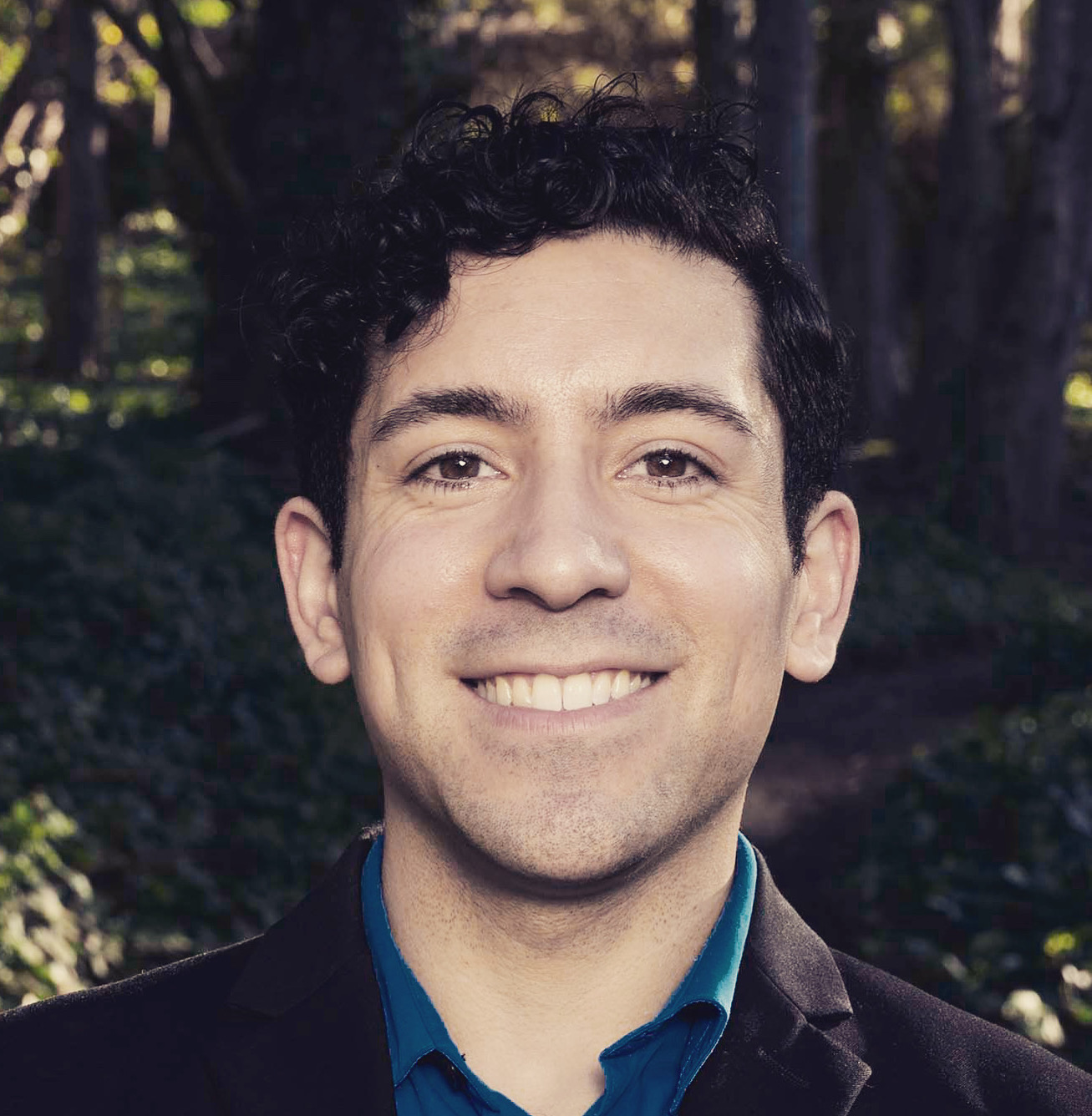
What does it mean to be a non-Indigenous person living on Indigenous land? With the increasing conversations about racial justice in the US, many institutions and organizations have adopted the practice of land acknowledgements. These statements often speak of the Indigenous peoples of a given territory and may recount the history of dispossession. Native and non-Native scholars and community members have sometimes critiqued these as shallow performances of allyship. Yet, when taken seriously, they offer an invitation to think more deeply about the relationships that we collectively have to the lands on which we reside—whether Indigenous, Black, migrant, and/or settler peoples. Considering these relationships to land and to Indigenous peoples opens up possibilities for what it might mean to move beyond performative allyship towards learning how to be a guest in Indigenous homelands.
For instance, a section from the land acknowledgment from my own university, Texas Christian University, invites us to reflect on relationship. Alongside the creation of an Indigenous monument, the land acknowledgement reads:
As a university, we acknowledge the many benefits we have of being in this place. It is a space we share with all living beings, human and non-human.…The monument created jointly by TCU and the Wichita and Affiliated Tribes reminds us of our benefits, responsibilities, and relationships. We pause to reflect on its words: This ancient land, for all our relations… TCU especially acknowledges and pays respect to the Wichita and Affiliated Tribes, upon whose historical homeland our university is located.
Among the many elements of this statement, written by members of the TCU Native American Advisory Circle, is relationship. As many Indigenous scholars have noted, Indigenous thought often situates land as a site of relationships between humans, plants, animals, and sacred beings. Yet too few non-Indigenous peoples consider our own relationships to land. Red River Métis/Michif scholar Max Liboiron reminds us that “assumed access to land is fundamental to so many settler relations. Land relations are central not only to Indigenous worlds, but also to settler worlds” (68).

The structures of settler colonialism impact all of us, as Indigenous feminist scholars Malie Arvin (Kānaka Maoli), Eve Tuck (Unangax̂), and Angie Morill (Klamath Tribes) argue. Liboiron writes, however, about how our distinct relations to land and colonialism often remain invisible. In academic literature, for example, Native scholars are often marked as such with their particular affiliation to their Native Nation or community. The same is not always true of non-Native scholars who typically remain “unmarked,” as if neutral or disconnected from land or colonial occupation. Liboiron notes, “This unmarking is one act among many that re-centers settlers and whiteness as unexceptional norm, while deviations have to be marked and named.” It assumes “settler presence on Land, especially Indigenous Land, is the stable and unremarkable norm” (3, footnote 10). Black, Indigenous, and Black-Indigenous scholars such as Tiffany Lethabo King, Alaina E. Roberts, and Kyle T. Mays (Saginaw Chippewa) describe the more complex ways that Black peoples relate(d) to Indigenous lands than either settlers or migrants.
Taking Liboiron seriously means marking my own position as a non-Native person from an immigrant Central American and Mexican family born and raised in the San Francisco Bay Area. The San Francisco Bay Area is the land of the multiple Ohlone tribes and family lineages and home to diverse relocated and diasporic Indigenous peoples today. My journey to understand the San Francisco Bay Area and its history led me to engage in fieldwork among diverse Ohlone communities and to participate in various protests, cultural events, and ceremonies. I love this land and also recognize that my sense of belonging to this place has been shaped by Spanish, Mexican, and American colonization. I also recognize that these colonial legacies mean that Indigenous peoples remain largely dispossessed along the California coast.

My work in the academy and in community has been shaped by the question of what it might mean to live as a respectful guest on Indigenous land. Many non-Native people take for granted our relationships to land or relate to land largely as property. Non-Native scholar Robert Nichols theorizes the ways that settler colonialism transforms non-proprietary forms of relationships to land into commodities. Through this transformation, the original “owners” (Indigenous peoples) are only owners retroactively, a process he calls “retroactive dispossession.” The colonial process of dispossession occurs alongside other forms of violence such as racial supremacy, gendered and sexual violence, enslavement, exploitation, and attacks on Indigenous governance. All of this remains largely invisible, which is likely why many non-Native people have the luxury of not considering our relationship to land or the ways it has been conditioned by settler colonialism.
In the wake of ongoing histories of colonial violence, Native and non-Native scholars and community members have considered what respectful relations might look like. Writing in the context of Hawai’i, Japanese American scholar Candace Fujikane considers a “settler-aloha ʻāina.” This refers to the ways that non-Native people may develop a sense of aloha (love) for āina (land) and work towards Kānaka Maoli (Native Hawaiian) sovereignty and independence. “Settler-aloha ʻāina” moves beyond the settler-Native binary to consider the potential of good relations to land. Importantly, Fujikane argues that settler-aloha ʻāina does not erase the distinct ways that settler colonialism impacts Black, Indigenous, settler, and people of color differently. At the same time, it opens the possibility of respectful relations between settlers and Indigenous peoples.
‘Settler-aloha ʻāina’ moves beyond the settler-Native binary to consider the potential of good relations to land.
Considering relationship to land can open to responsibility. Fujikane writes, “As settler aloha ʻāina we can wehe [open to Kānaka Maoli knowledges] ourselves to love the land, even as we are learning the way to best enact practices that are reciprocal. While part of our kuleana [responsibility] is to play a supportive role, that should not prevent us from actively challenging the occupying state or standing against law enforcement” (16). Non-Native people not only have a relationship to land, but also have the potential of being in respectful relations, relations that grow out of respect, humility, and care. Such perspective moves beyond a shallow performance of allyship that writers like queer Black essayist Mia McKenzie critique. Instead, it allows for the potential for robust forms of solidarity in the future and a responsibility towards making amends for past harms.
Part of a robust solidarity is accepting feedback. Fujikane no longer uses the term “settler aloha ʻāina.” In a Twitter post, she writes, “I having [sic] been using the term ‘settler aloha ‘āina’ that Noe Goodyear Ka’ōpua posed as a possibility in 2014. But there have been Kānaka Maoli who don’t like that term because they define it as being genealogically descended from lands. I am reverting back to using ‘settler ally.’”
Non-Native people not only have a relationship to land, but also have the potential of being in respectful relations, relations that grow out of respect, humility, and care.
Tongva and Acjachemen scholar Charles Sepulveda similarly considers respectful relations, through the Tongva concept of kuuyam, “guest.” Sepulveda argues that situating oneself as kuuyam “can disrupt setter colonialism” by restoring landscapes, eradicating hierarchies, and building relationships based in “responsibility and protocol.” He writes, “Kuuyam allows for a re-centering of place, and instead of dividing people into categories (and binaries) it allows for people to understand themselves as guests of the land—either they behave appropriately, or they do not” (57).

Anishinaabe and Ukrainian writer Patty Krawec notes that there are no easy solutions. Instead, she writes, “We have to build relationships.…Living as if the land belonged to the people we acknowledge means forming and working through relationships” (146). This includes learning about and having discussions in community about the land where one lives—the Indigenous peoples, treaties, place names, histories, and current struggles connected to that place. It means organizing the people where you live to support Indigenous-led movements, especially movements connected to the return of land to Indigenous peoples. It also means understanding that relationship to land is conditioned by one’s relationship to legacies of colonialism, enslavement, and displacement.
In the helpful guide “How to Come Correct” created by members of the Indigenous-run organization Sogorea Te’ Land Trust, they include “Be a good guest!” This line appears at the end of their list but in some ways may be the most profound suggestion. A guest is welcomed, but also must ask permission. Guests do not overstay or act entitled. To be a guest is also to recognize oneself as in relationship. The work of understanding one’s relation to land, to legacies of colonialism and resistance, and the ways that one might act in good relations is a life-long process. Eve Tuck (Unangax̂) and K. Wayne Yang (diasporic settler of color) write that, “Solidarity is an uneasy, reserved, and unsettled matter that neither reconciles present grievances nor forecloses future conflict” (3).
At the same time, the violence of colonialism was never inevitable. As I tell my students often, the settlers that came here made choices. Considering our relations and responsibilities to land invites us to make other choices, ones that might guide us, perhaps, towards being in good relations with the land and the Indigenous peoples of that place. This also comes with invitations to reckon with the past and do the work of repair for the colonial legacies we have inherited. Krawec reminds us, “Being a settler or a colonizer is not something you are it is something you do. It describes your relationship to this land and the people in it.…If you are going to stop being a settler and start being kin, that’s where we start. With what you do” (178–79).

